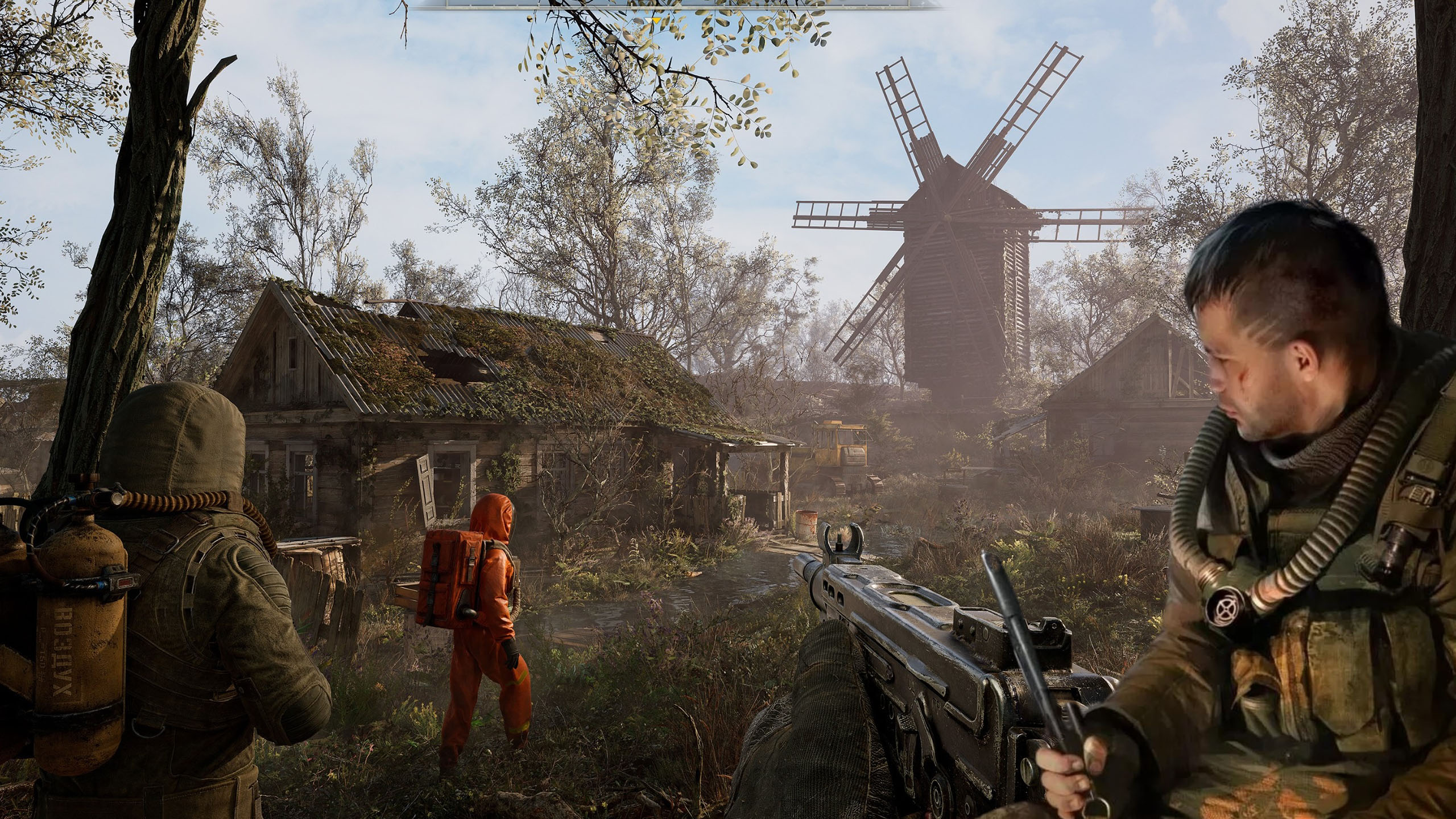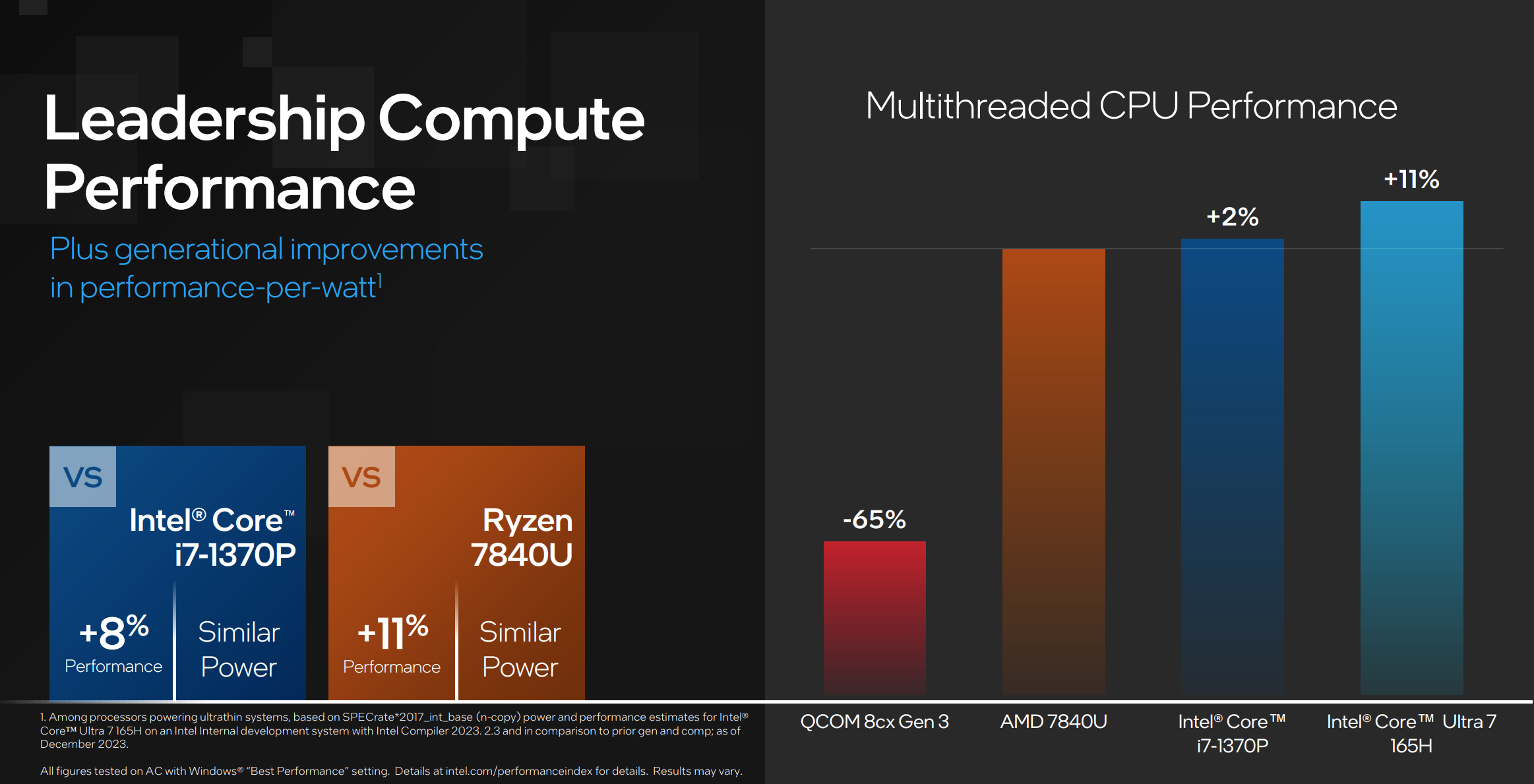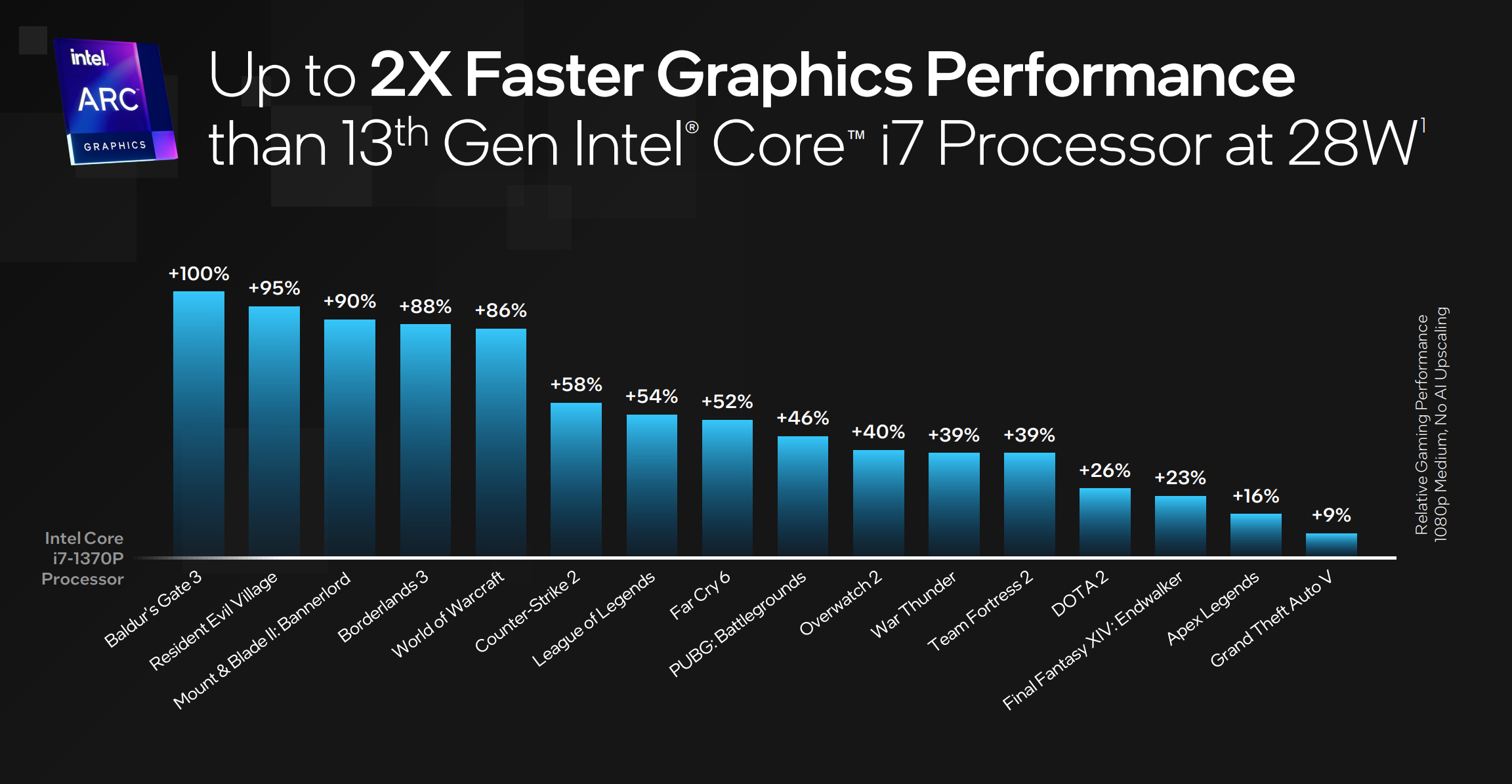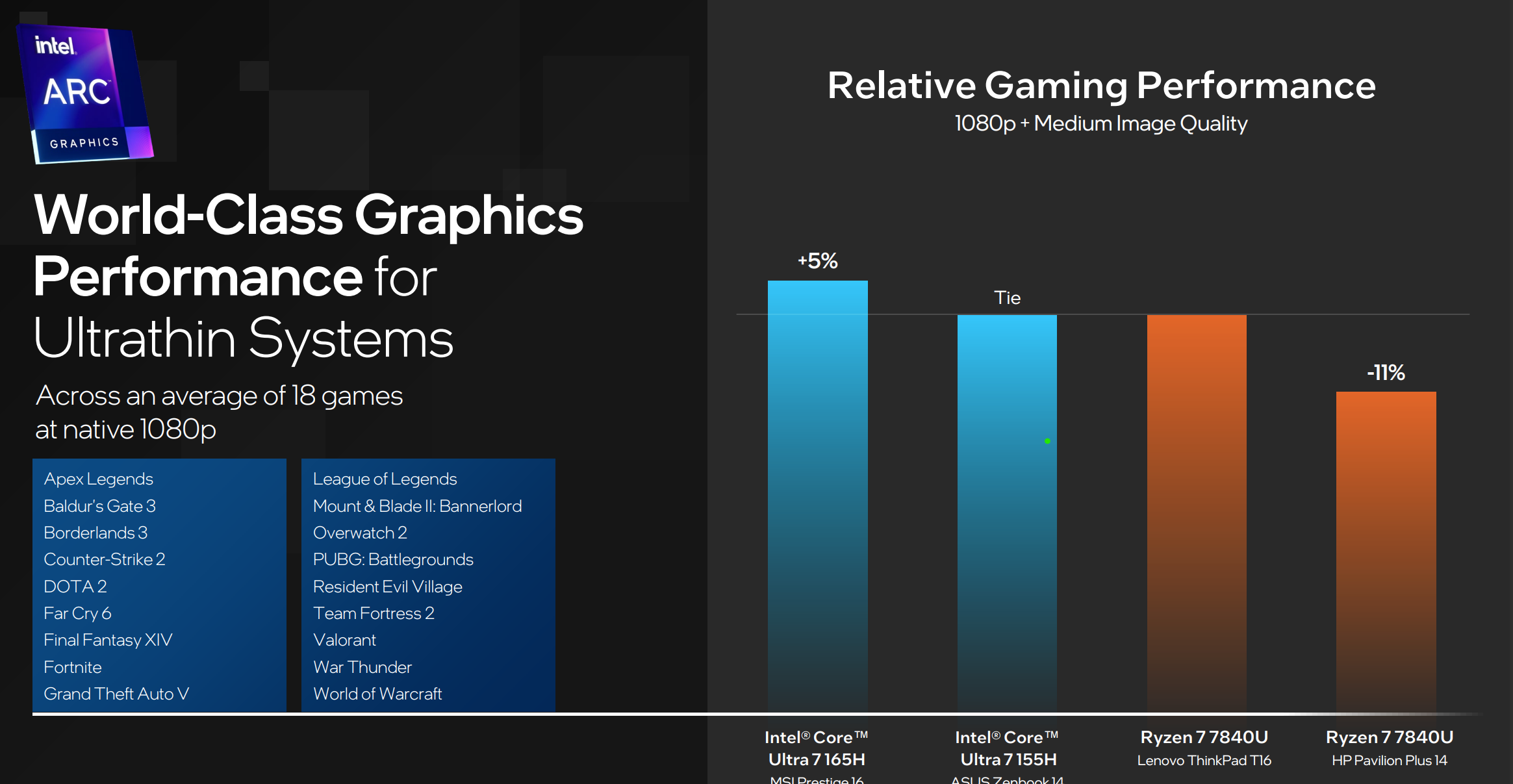Laptops begin shipping today, ushering in the AI PC.
Intel’s Core Ultra era begins now! Intel is shipping its first “Meteor Lake” 14th-gen Core Ultra chips in laptops beginning today, ushering in the new “AI PC” era — as well as actually telling you what’s in them and how fast they’re expected to be.
Though leaked benchmark results, we’ve known a bit about Intel’s Core Ultra product lineup. But now it’s official: Intel will offer eleven new mobile Core Ultra processors, both in the “H” high-performance segment and the low-power “U” family. Intel has disbanded the earlier “P-series” lineup. Not surprisingly, Intel is claiming performance leadership over AMD’s Ryzen chips, though the comparisons are being made to the older Ryzen 7000 or Ryzen 7040 family rather than the just-announced Ryzen 8000 CPUs.
As Intel spelled out in our deep dive into the Meteor Lake architecture, Core Ultra’s selling points are significantly lower power via its use of the Intel 4 process technology, plus a sharp boost in graphics performance. The third pillar, AI, is a little murkier: The rise of the AI PC may be a bit slower than Intel would like, as software developers learn and take advantage of the new “neural processing unit” inside Meteor Lake throughout 2024. Incidentally, that’s when you’ll have to wait for the first Core Ultra 9 chip.
These Core Ultra processors — aside from three which will launch in the first quarter or 2024 — will appear in more than 230 unique PCs from more than 35 PC makers, Intel said, beginning with laptops shipping today. We know of what Acer and Lenovo are planning, among others.
So what’s new? The numbers: both the details of the chips and how they compare. Let’s dive in.
See more from Intel’s Core Ultra (Meteor Lake) launch:
What are the Intel Core Ultra chips?
Intel’s new Core Ultra processors do away with the “i” that was in previous versions of Intel’s Core chips, replacing it with the (unnecessary?) Ultra adjective instead.
Remember, too, that there are now even-lower-power efficiency cores (designated as LP E-cores) as well as efficiency cores (E-cores), which will serve as the first point of attack for any new task. Only the performance (P-cores) use hyperthreading…and now both P-cores and E-cores have their own boost speeds. The integrated GPU has its own speed and number of Xe cores. Finally, even the NPUs have their own defining characteristics. All these conspire to make the chip descriptions longer than they ever have before.
We begin with the H-series parts, which require a minimum of 28 watts of base power and scale up to either 64W or 115W of maximum turbo power. (Intel executives said that the chips can be run between 20W and 35W, pushing the turbo power to 64W; otherwise, if the chips are set to 35W-65W of base power, the turbo power consumed can be as high as 115W.)

Intel
We give a brief summary here; look at Intel’s graphic above for the full breadth of detail.
- Intel Core Ultra 7 165H: 16 cores/22 threads (6P/8E/2LPE) at 5.0GHz P-core Turbo; Arc GPU (8 Xe, 2.3GHz); 2X Gen3 AI Boost
- Intel Core Ultra 7 155H: 16 cores/22 threads (6P/8E/2LPE) at 4.8GHz P-core Turbo; Arc GPU (8 Xe, 2.25GHz); 2X Gen3 AI Boost
- Intel Core Ultra 5 135H: 14 cores/18 threads (4P/8E/2LPE) at 4.6GHz P-Core Turbo; Arc GPU (7 Xe, 2.2GHz); 2X Gen3 AI Boost
- Intel Core Ultra 5 125H: 14 cores/18 threads (4P/8E/2LPE) at 4.5GHz P-Core Turbo; Arc GPU (7 Xe, 2.2GHz); 2X Gen 3 AI Boost
Again, the new H-series parts consume 28W. A generation ago, Intel’s 13th-gen, 28W processors were named the “P series” parts, not H — and those P-series parts have now vanished at the request of PC makers, Intel executives said. The 13th-gen H-series parts consumed 45W at a minimum instead.
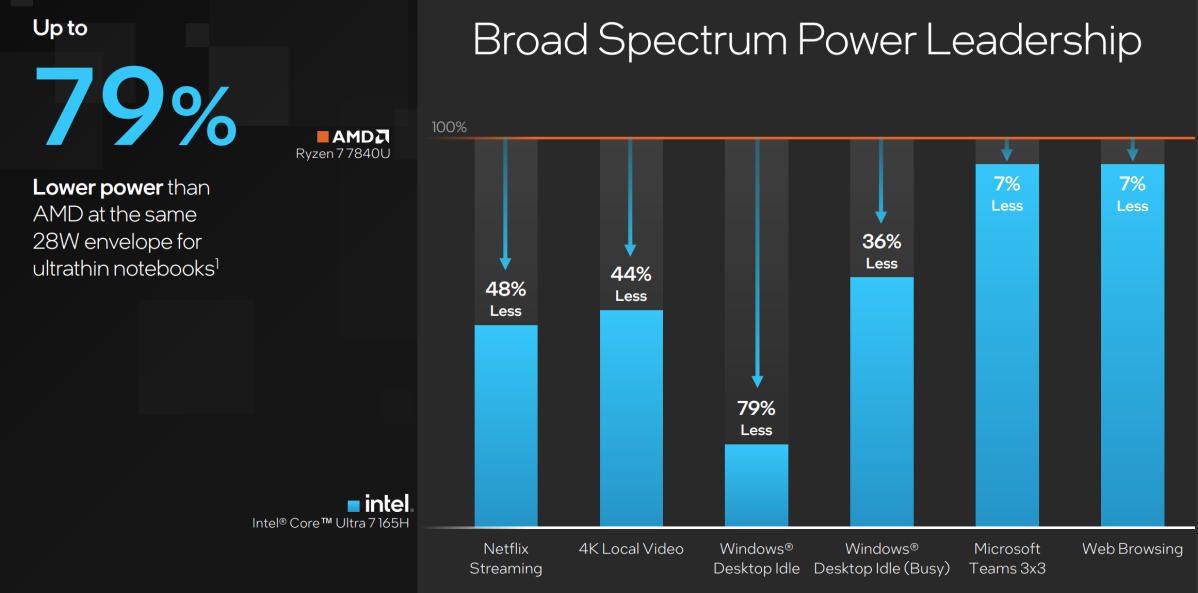
Intel
Two common trends stick out. The persistence of just two low-power E-Cores (LPE) across both the H- and U-series chips; and the NPU, which is consistently just Intel’s dual-engine third-generation AI Boost, following the AI technology first acquired from Movidius and its subsequent adaptation into the AI cards in some 13th-gen Core notebooks.
We’d expect both of these to fluctuate in subsequent generations, as Intel develops a 4th-gen NPU and possibly tweaks the LPE cores as well. And what’s the difference between an Arc Graphics integrated graphics core and and a more generic Intel Graphics core? Apparently just the number of Xe cores inside it, along with 16Gb of shared system memory across a dual-channel bus.
The U-series versions of the Core Ultra are designed as 15W processors, with turbo power scaling up to 57W. (Intel’s 13th-gen U-series were also 15W parts, scaling to 55W.)
- Intel Core Ultra 7 165U: 12 cores/14 threads (2P/8E/2LPE) at 4.9GHz P-Core Turbo; Intel Graphics (4 Xe, 2.0GHz); 2X Gen 3 AI Boost
- Intel Core Ultra 7 155U: 12 cores/14 threads (2P/8E/2LPE) at 4.8GHz P-Core Turbo; Intel Graphics (4 Xe, 1.95GHz); 2X Gen 3 AI Boost
- Intel Core Ultra 5 135U: 12 cores/14 threads (2P/8E/2LPE) at 4.4GHz P-Core Turbo; Intel Graphics (4 Xe, 1.9GHz); 2X Gen 3 AI Boost
- Intel Core Ultra 5 125U: 12 cores/14 threads (2P/8E/2LPE) at 4.3GHz P-Core Turbo; Intel Graphics (4 Xe, 1.85GHz); 2X Gen 3 AI Boost
Remember Intel is betting big on lower power. The company claims that a Meteor Lake laptop will use 79 percent less power while you’re sitting there, staring at the Windows desktop, compared to a Ryzen 7 7840U. You’ll use 48 percent less power streaming Netflix, Intel says, and 25 percent less versus the Core i7-1370P.
Trending for you
At a system level, Intel is working with laptop makers to design new “Evo Edition” laptops with ten hours of battery life on 1080p screens. (Higher resolutions drop the battery-life requirements.) Reducing the power consumption allows laptops to include a sufficient amount of physical battery capacity to actually hit that goal.
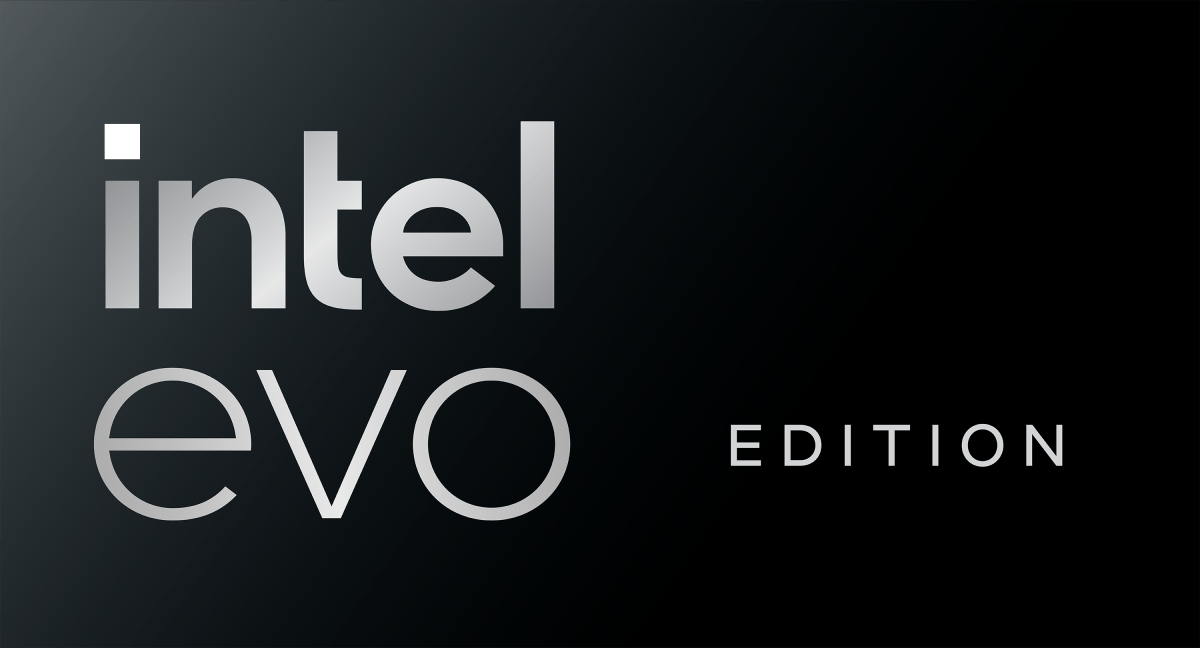
Intel
Intel is also tipping off a few planned additions to the Meteor Lake/Core Ultra family, due later in the first quarter — including its first Core Ultra 9 chip. Note that these are a mixed bag of “H-” and “U-“series parts.
- Intel Core Ultra 9 185H: 16 cores/22 threads (6P/8E/2LPE) at 5.1GHz P-Core Turbo; Arc GPU (8 Xe, 2.35GHz); 2X Gen 3 AI Boost
- Intel Core Ultra 7 164U: 12 cores/14 threads (2P/8E/2LPE) at 4.8GHz P-Core Turbo; Intel Graphics (4 Xe, 1.8GHz); 2X Gen 3 AI Boost
- Intel Core Ultra 5 134U: 12 cores/14 threads (2P/8E/2LPE) at 4.4GHz P-Core Turbo; Intel Graphics (4 Xe, 1.75GHz); 2X Gen 3 AI Boost
At press time, it wasn’t clear why the available memory capacity would vary with the type of memory, i.e. 64GB of LPDDR5 memory versus 96GB of DDR5 memory. The 9W U-series chips will have a different I/O tile, with fewer PCIe 5 lanes and a smaller number of Thunderbolt 4 ports, Vijay Krishnamurthy, senior director of product management for the Client Computing Group, said.
Because they’re notebook parts, Intel does not disclose prices of the Core Ultra chips.
What features will be in Core Ultra notebooks?
Notebooks with Intel 14th-gen Core Ultra chips inside them should probably remind you of the earlier generation, with a couple of exceptions. Intel has disclosed previously that the Meteor Lake generation of its Core Ultra platform won’t include Thunderbolt 5, but it will support four Thunderbolt 4 ports, rather than the conventional two. Likewise, you won’t see WiFi 7 without the laptop maker committing to installing a discrete card; otherwise they’ll include WiFi 6E instead.
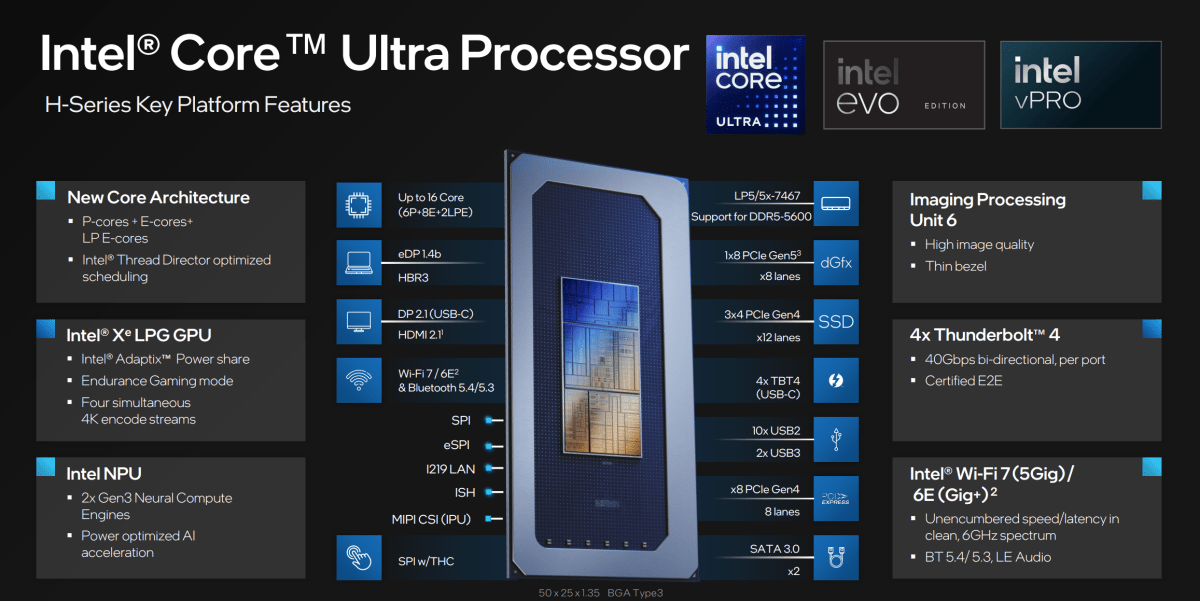
Intel
Inside, however, Meteor Lake adds in a single x8 PCI Express 5 connection, plus twelve lanes (three X4 connections) of PCI Express 4 and a single x8 PCIe4 connection, too. While the platform supports two USB3 and 10 USB2 ports, it’s doubtful you’ll ever see a laptop with all of them.
The platform also supports Bluetooth 5.4, whose main feature seems to be the ability for a laptop to connect and talk to thousands (!) of other devices at once, using encrypted communications.
How fast is Intel’s Core Ultra (Meteor Lake)?
We now know how fast Meteor Lake will be, at least from Intel’s own, unverified, testing.
Intel claims that Meteor Lake-based Core Ultra laptops powered by the Intel Core Ultra 7 165H will outperform the AMD 7840U by 12 percent in single-threaded CPU performance, but that it will also drop compared to the Intel Core i7-1370P.
However, Intel is also saying that in the real world, the entirety of the Core Ultra chips will outperform the Ryzen 7 7840U. To be fair, AMD just announced the Ryzen 8000 / 8040 CPUs, but acknowledged they were architecturally very similar to the earlier Ryzen 7000 family.
But it’s the GPU performance that truly elevates the Core Ultra, Intel is also saying. Compared to the Core i7-1370P, the Core Ultra 7 165H outperforms it by up to 100 percent on the game of the year, Baldur’s Gate 3 (at 1080p resolution, Medium settings), and offers about the same level of performance in an ultrathin notebook as the AMD Ryzen 7 7840U.
Tack on Intel’s XeSS (Xe Super Sampling) technology, and frame rates can almost triple from the 13th-generation hardware, Intel said. XeSS takes advantage of Intel’s AI inferencing instructions, providing graphics upscaling. (Our explainer has more.) XeSS is running on over 90 games, executives said.
How powerful is the AI inside the Core Ultra?
It’s in AI, however, that Intel and AI PCs really hope to shine.
Here, there is some tension. The Meteor Lake architecture underpinning these Core Ultra chips is Intel’s first with an integrated neural processing unit (NPU), which will work together with the GPU and CPU to perform AI calculations. Intel is claiming 34 trillion operations per second (34 TOPS). That’s somewhat behind what Qualcomm is claiming with its Snapdragon X Elite (75 TOPS) and AMD (39 TOPS) with its Ryzen 8040 series and its Hawk Point NPU. But Intel is also trying to come up with ways that applications developers can take advantage of its silicon, so that its efforts haven’t been in vain.
Remember, AI PCs run AI locally on the PC, rather than in the cloud. In 2023, that means that PC buyers will have a choice between running a dedicated AI app (such as a chatbot or an AI art generator like Stable Diffusion) on their local hardware, or else use one of an existing series of apps that have been re-coded with AI in mind. Intel is claiming up to 100 app developers are working with the company, including names like Adobe, Microsoft, Zoom, Audacity, Dolby, and Cisco’s WebEx.

Intel
Intel is also claiming that the NPU can be used to improve performance (1.7X better in Stable Diffusion, compared to the Core i7-1370P) and be used to save power (38 percent less power used in Zoom.) It also showed off some performance data in various apps, such as Premiere Pro and Wondershare Filmora, whose performance improved once AI features were enabled.
It all remains to be seen whether users will pick up on the new AI capabilities or simply use AI-infused PCs, including those powered by the Core Ultra, as just traditional laptops. But the stage is set for the next generation of PC hardware nevertheless.


